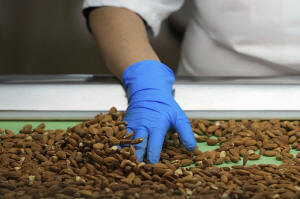California almond growers grapple with uncertainty as new tariffs could
hit exports
[March 12, 2025] By
TERRY CHEA and AMY TAXIN
NEWMAN, Calif. (AP) — California almond growers are used to dealing with
swings in the weather and water supply. Now they must also grapple with
the uncertainty of trade battles as the Trump administration levies
tariffs on goods from several countries and weighs adding more to the
list.
With more than three-quarters of California's almond crop headed for
export, tariffs could impact where the nut is headed and send ripple
effects throughout the state's economy, experts said. The state is the
biggest producer of the world's almonds, accounting for about 80 percent
of the global supply.
Already, China has responded to Trump's move by raising tariffs on U.S.
almonds — and that's on top of tariffs levied on the nut in the last
Trump administration.
“If we start a trade war with, you know, India, the European Union,
parts of the Middle East, then the almond industry in California is
going to suffer dramatically,” said Colin Carter, agricultural economist
and professor emeritus at University of California, Davis. “The price
will fall even further and you’ll see orchards being ripped out, farms
being lost. There'd be farms for sale up and down the Valley.”
Just weeks into his second term, President Donald Trump has slapped 10%
tariffs on China and threatened, then delayed for 30 days, 25% taxes on
goods from Canada and Mexico. He has also threatened to expand the trade
war by levying reciprocal tariffs on a number of products to match what
other countries charge on U.S. goods, which economists say is creating a
tough environment for already-challenged farmers trying to plan ahead.

Meanwhile, Trump's moves have drawn retaliation from U.S. trading
partners. China, for example, has said U.S.-grown chicken, wheat, corn
and cotton will face an extra 15% tariff while sorghum, soybeans, pork,
beef, seafood, fruit, vegetables and dairy products will face an
additional 10% — and so will almonds.
Almonds are California's biggest agricultural export, and the state
reeled in $4.7 billion from almond exports in 2022 with about half going
to the European Union and India, state farm data shows.
Almond experts said the key for California will be continuing to pursue
a range of export markets. “While China continues to be an important
market, California almonds are shipped to more than 100 destinations,
therefore maintaining a diverse export program is essential,” said Rick
Kushman, spokesperson for the Almond Board of California.
[to top of second column] |

Angelita Delgado sorts through almonds by hand at Stewart and Jasper
Orchards, Friday, March 7, 2025, in Newman, Calif. (AP Photo/Godofredo
A. Vásquez)
 Many California farmers in the
crop-rich Central Valley have welcomed some of Trump's other
policies, specifically aimed at getting more water to their fields.
The area — which grows much of the country's fresh produce including
citrus fruit and almonds — is largely Republican in a widely
Democratic state.
But California's almonds will now face a total tariff of 35% in
China. That's because Beijing placed tariffs on almonds during
Trump's first administration in response to tariffs he levied on
Chinese products. The move made California's almonds relatively more
expensive to nuts from Australia, which as a result gained market
share in China while California's almond experts to China declined,
experts said.
Since then, many California almond exporters have shifted their
focus to other markets, said Zachary Williams, sales director for
Stewart & Jasper Orchards in Newman, Calif. He said Canadian buyers
currently are scooping up California almonds ahead of tariffs
potentially taking effect since the state grows so much of the
world's supply. He said any attempt by India to raise tariffs could
spark concern the nut might grow too pricey for consumers there.
The tariffs are a challenge, he said, but an even bigger one is the
lack of certainty for almond growers who don't expect to harvest a
new orchard for at least three years and then plan to grow it for
two decades.
“The uncertainty is probably more of a problem than the tariff
itself,” Williams said. “Uncertainty about whether there will be, or
won't be, is a little harder to plan around.”
—
Taxin reported from Santa Ana, Calif.
All contents © copyright 2025 Associated Press. All rights reserved
 |